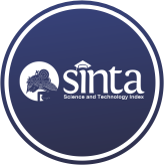Penerapan Linear Sequential Model Dalam Merancang Aplikasi Penjualan Pakaian Berbasis Web Pada Distro Kael
(1) STMIK Jakarta STI&K, Jakarta Selatan, Indonesia
(2) STMIK Jakarta STI&K, Jakarta Selatan, Indonesia
(3) STMIK Jakarta STI&K, Jakarta Selatan, Indonesia
(*) Corresponding Author
Abstract
This research aims to apply a sequential linear model in the development of a web-based clothing sales application, with a case study at Distro Kael. This development method involves sequential steps in system design, starting from inventory management, ordering, to payment. The main emphasis is placed on ease of use, responsiveness of the interface and a satisfying shopping experience. The implementation of the linear sequential model is expected to increase distro operational efficiency and provide a more structured shopping experience for customers. The evaluation results will include application performance, system responsiveness, and user satisfaction level, as indicators of the success of implementing this model in the context of online clothing sales at Distro Kael.
Full Text:
PDFReferences
M. Pradana, “Klasifikasi Bisnis E-Commerce Di Indonesia,” MODUS, vol. 27, no. 2, p. 163, Mar. 2016, doi: 10.24002/modus.v27i2.554.
Y. I. Chandra, D. Gustina, and S. Sutarno, “Perancangan Sistem E-Commerce F&B di Fresh Time Jakarta Menggunakan Model V Berbasis Web Mobile,” J. Esensi Infokom J. Esensi Sist. Inf. Dan Sist. Komput., vol. 6, no. 2, Art. no. 2, Oct. 2022, doi: 10.55886/infokom.v6i2.499.
I. U. Rabbani, “E – Commerce Perlengkapan Haji Dan Umroh Berbasis Web Menggunakan Metode Agile Software Development,” Pros. Semin. Nas. Mhs. Bid. Ilmu Komput. Dan Apl., vol. 1, no. 2, Art. no. 2, Nov. 2020.
D. A. Vikry, I. Darmawan, and N. Ambarsari, “Perancangan Dan Pembangunan E-commerce Studiospace Menggunakan Framework Codeigniter Dengan Metode Iterative Incremental,” EProceedings Eng., vol. 6, no. 1, Art. no. 1, Apr. 2019, doi: 10.34818/eoe.v6i1.8992.
H. Nur, “Penggunaan Metode Waterfall Dalam Rancang Bangun Sistem Informasi Penjualan,” Gener. J., vol. 3, no. 1, Art. no. 1, Jan. 2019, doi: 10.29407/gj.v3i1.12642.
F. Sonata, “Pemanfaatan UML (Unified Modeling Language) Dalam Perancangan Sistem Informasi E-Commerce Jenis Customer-To-Customer,” J. Komunika J. Komun. Media Dan Inform., vol. 8, no. 1, Art. no. 1, Jun. 2019, doi: 10.31504/komunika.v8i1.1832.
Y. I. Chandra, D. R. Irawati, S. Widayati, and K. Airinia, “Rancang Bangun Aplikasi Undangan Pernikahan Online Menggunakan Metode Waterfall Berbasis Web Mobile,” J. SASAK Desain Vis. Dan Komun., vol. 4, no. 2, Art. no. 2, Sep. 2022, doi: 10.30812/sasak.v4i2.2195.
M. H. Ekasari, E. T. Asmoro, and Y. I. Chandra, “Rancang Bangun Aplikasi Pendaftaran Dropshipper dan Reseller Menggunakan Model Sequential Linier Berbasis Web Mobile,” J. Esensi Infokom J. Esensi Sist. Inf. Dan Sist. Komput., vol. 6, no. 2, Art. no. 2, Oct. 2022, doi: 10.55886/infokom.v6i2.498.
Kosdiana, Y. I. Chandra, and E. Orlando, “Perancangan Media Informasi Restoran Menggunakan Model Sequential Linier Berbasis Web (Studi Kasus Pada Aris Restoran),” J. SIKOMTEK, vol. 12, no. 2, Art. no. 2, Jul. 2022.
N. Dwivedi, D. Katiyar, and G. Goel, “A Comparative Study of Various Software Development Life Cycle (SDLC) Models,” Int. J. Res. Eng. Sci. Manag., vol. 5, no. 3, Art. no. 3, Mar. 2022.
DOI: https://doi.org/10.30645/kesatria.v5i1.330
DOI (PDF): https://doi.org/10.30645/kesatria.v5i1.330.g327
Refbacks
- There are currently no refbacks.
Published Papers Indexed/Abstracted By:














